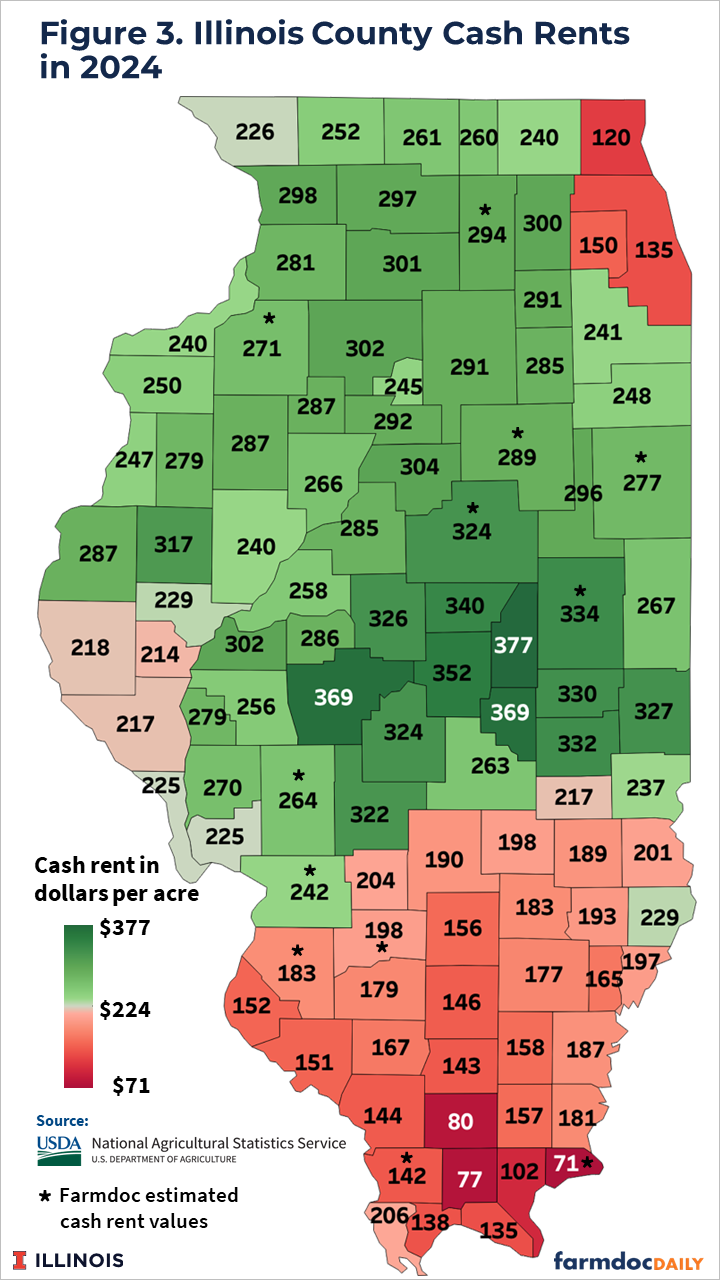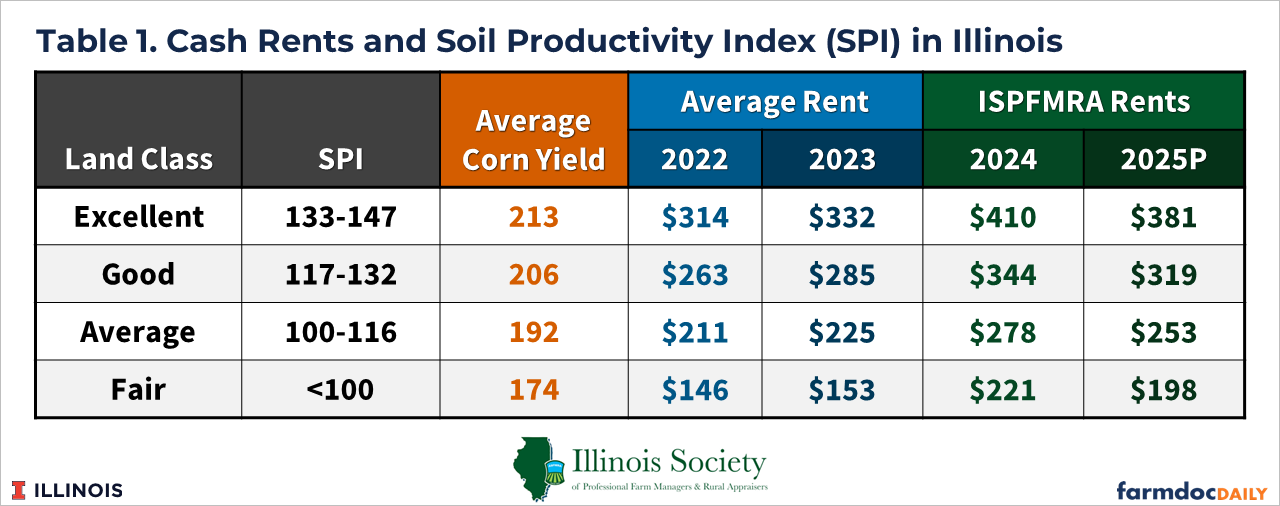Setting 2025 Cash Rents
We present information helpful in evaluating cash rent levels for the 2025 production year (see farmdoc daily, July 30, 2024). In recent years, average cash rents published by the U.S. Department of Agriculture have shown significant increases, with the impetus for those increases coming from above-average farming returns from 2020 to 2022. However, returns likely will be negative in 2024. As a result, a survey by the Illinois Society of Professional Farm Managers and Rural Appraisers suggests decreases in cash rents in 2025 are expected. Given that returns are expected to remain low in 2025, substantial declines in cash rents seem warranted. As a benchmark, reducing cash rents back to 2020 levels would help, particularly for cash rents that are at or above NASS averages.
Projected Farmland Returns
Negotiations for 2025 cash rents will occur against negative 2024 farmland returns. For example, our projections place returns at -$129 per acre for high-productivity farmland in central Illinois at average cash rent levels for the region, the lowest return since we began computing comparable returns in 2000 (see Figure 1). Those negative returns are $36 below the 2024 return of -$93 per acre. Before 2023, the lowest returns were in 2014 (-$3 per acre) and 2025 (-$10 per acre).
Average 2024 Cash Rents in Illinois
The National Agricultural Statistics Service (NASS) reported the average cash rent for Illinois in 2024 at $269 per acre, up by $10 per acre from $259 per acre for 2023 (see Figure 2). The 2024 rent is another new record for Illinois and continues a trend of significant increases since 2020. Between 2020 and 2024, average cash rents in Illinois increased by $47 per acre. From 2020 through 2022, returns were above average (see Figure 1), providing the impetus for increasing cash rents.
Cash rents vary across Illinois, as illustrated in Figure 3, which shows average county cash rents for non-irrigated cropland released by NASS on August 23. This year, NASS did not report cash rents for some significant agricultural counties in Illinois. In Figure 3, rents for unreported counties were estimated based on a regression analysis, discussed below, relating rent levels to a county-level soil productivity index with agricultural district adjustment factors.
As is typical, cash rents are highest in the central part of the state and lowest in southern Illinois. The highest cash rent of $377 per acre occurred in Piatt County, a county in central Illinois. The lowest cash rent of $77 per acre occurred in Johnson County, a county in southern Illinois.
Differences in soil productivity explain much of the variation in cash rents. Figure 4 shows a scatter graph of the average 2024 county cash rents related to the average county soil productivity index (SPI). The SPI is published for Illinois soils by the Department of Natural Resources and Environmental Sciences at the University of Illinois (click here for more information). County cash rents and SPIs have a strong, positive correlation coefficient of .87.
The SPIs of farms within a county can vary from the county average. Relationships between county cash rents and SPIs were fit to aid in calculating cash rents for a specific field’s SPI (see farmdoc daily, November 7, 2017, for a discussion). The following equation was fit to 2024 county cash rents and average SPI data:
“Average” cash rent = -202+ (3.76 x SPI) + CRD adjustment
where CRD is the crop reporting district. CRD adjustment values are shown in Figure 5.
To illustrate, take a farm with a 134 SPI in Champaign County. Champaign County is in the East CRD with a CRD adjustment of $25 (see Figure 5). Given this information, the average cash rent is estimated at $326 per acre (-202 + 3.76 x 134 PI + $25 CRD adjustment).
Variability in Cash Rents
Actual farm-level cash rents exhibit significant variation from the above averages. For example, 60% of the rents on McLean County farms enrolled in Illinois Farm Business Farm Management (FBFM) in 2019 were within a range from $214 to $287 per acre. The remaining 40% of the rents were outside that $73 per acre range. Rent variations often are due to the farm’s characteristics, including soil productivity, drainage, land access, land terrain, field size, and field obstructions. The desires of landowners and attributes of the relationship between the landowner and tenant also play a prominent role in rent levels.
Professionally Managed Farmland
Annually, the Illinois Society of Professional Farm Managers and Rural Appraisers (ISPFMRA) conducts a mid-year survey to ask its members about cash rent expectations in the upcoming year. This mid-year survey is part of the Society’s land value effort, which produces a land value booklet each year, giving farmland prices and rental information by state regions (click here for an archive of reports).
The ISPFMRA reports cash rents by four land classes: excellent, good, average, and fair. Land class divisions are made based on SPI ratings, with excellent farmland having SPIs ranging from 133 to 147. SPI ranges for the remaining classes are shown in the first column of Table 1. Average corn yields vary by land class. For example, corn yield averaged 213 bushels per acre from 2018 to 2022 for counties with average SPIs over 133 (see Table 1). The average corn yields over the same period were lower for other classes: 206 bushels per acre for the good land class, 192 for the average land class, and 174 for the fair land class.
For 2024, the ISPFMRA reported an average rent for excellent quality farmland that is professionally managed at $410 per acre. As with all rents, there is a considerable range around the average. For counties with SPIs above 133, the average of cash rents reported by NASS was $332 per acre. Professionally managed farmland had a $79 higher per acre average cash rent.
Overall, professionally managed farmland has higher cash rents than NASS averages. Various reasons can be given for this difference, including the desires of farm owners who seek professional management for higher returns.
Outlook for 2025 Cash Rents
Professional managers of farmland are indicating that cash rents will decline in 2025. Decreases by land class are:
- Excellent quality farmland is projected to decrease $29 per acre from $410 per acre in 2024 to a projected $381 in 2025.
- Good quality farmland is projected to decrease $25 per acre from $344 per acre in 2024 to a projected $310 in 2025.
- Average quality farmland is projected to decrease $25 per ace from $278 per acre in 2024 to a projected $253 in 2025.
- Fair quality farmland is projected to decrease $23 per acre from $221 per acre in 2024 to a projected $198 in 2025.
Those declines seem warranted, given the low returns expected for 2024 and projected for 2025.
Summary
Significant declines in 2025 cash rents are expected and may be necessary given negative expected returns for 2024, and a continued low return outlook for 2025. As a benchmark, reducing cash rents back to 2020 levels would help, particularly for cash rents that are at or above NASS averages. Rents at 2020 levels still would have resulted in negative returns for 2024 in most cases.
References
Schnitkey, G. "Determining the Average Cash Rent Based on Productivity Index." farmdoc daily (7):205, Department of Agricultural and Consumer Economics, University of Illinois at Urbana-Champaign, November 7, 2017.
Schnitkey, G., B. Zwilling, N. Paulson, C. Zulauf, B. Rhea and J. Baltz. "Increasing Pessimism About 2024 and 2025 Corn and Soybean Returns." farmdoc daily (14):141, Department of Agricultural and Consumer Economics, University of Illinois at Urbana-Champaign, July 30, 2024.
Disclaimer: We request all readers, electronic media and others follow our citation guidelines when re-posting articles from farmdoc daily. Guidelines are available here. The farmdoc daily website falls under University of Illinois copyright and intellectual property rights. For a detailed statement, please see the University of Illinois Copyright Information and Policies here.













